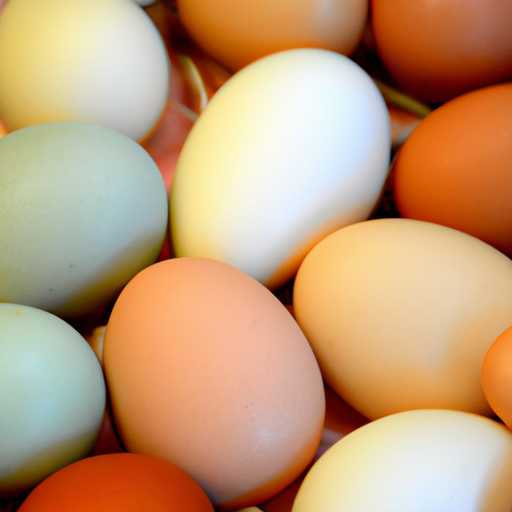Have you ever wondered about the fascinating world of chicken breeds and their egg-laying habits? If so, you’re in for a treat! In this article, we will explore the intriguing variations in egg-laying frequency among different chicken breeds. From the dependable layers to the occasional cluck, you will discover how these feathered friends differ in their productivity. Get ready to embark on a journey of discovery as we delve into the world of chickens and their marvelous eggs.
Different Factors Affecting Egg-laying Frequency
Egg-laying frequency in chickens can be influenced by various factors, including genetic, environmental, dietary, and age-related factors. Understanding these factors is crucial for poultry farmers and hobbyists alike, as it can help them make informed decisions about which breeds to choose and how to optimize egg production.
Genetic Factors
One of the significant factors affecting egg-laying frequency is genetics. Different chicken breeds have been selectively bred for specific characteristics, including egg production. Some breeds are known for their ability to lay a high number of eggs, while others have a more moderate or low egg-laying capacity.
Environmental Factors
The environment in which chickens are raised can also impact their egg-laying frequency. Factors such as temperature, humidity, lighting conditions, and overall living conditions can either promote or hinder egg production. Chickens thrive in conditions that mimic their natural habitat, so providing them with a comfortable and stress-free environment is essential for optimal egg production.
Dietary Factors
The nutrition that chickens receive plays a significant role in their egg-laying frequency. A well-balanced and nutritionally dense diet, rich in essential vitamins, minerals, and protein, is crucial for healthy egg production. Providing chickens with a diet that meets their specific nutritional needs can help maximize their egg-laying potential.
Age Factors
The age of chickens also affects their egg-laying frequency. Most chickens start laying eggs between 5 to 6 months of age, although the exact timing can vary depending on the breed. Egg production tends to peak during the first year and gradually declines as chickens age. However, with proper care and management, some breeds can continue to lay eggs at a reasonable frequency for several years.
High Egg-laying Chicken Breeds
There are several breeds known for their high egg-laying capacity. These breeds are popular choices for poultry farmers and backyard enthusiasts seeking to maximize egg production.
White Leghorn
The White Leghorn is a breed that consistently ranks high in terms of egg-laying frequency. Known for its prolific egg production, the White Leghorn is favored by commercial egg producers. These chickens are small and lightweight, making them efficient layers, and they typically produce white-shelled eggs.
Rhode Island Red
The Rhode Island Red is another breed renowned for its excellent egg-laying ability. These medium-sized chickens are hardy, adaptable, and known for their ability to lay brown eggs consistently. Rhode Island Reds are popular choices for small-scale egg production as well as for their meat.
Plymouth Rock
Plymouth Rock chickens, often referred to as “Barred Rocks,” are known for both their egg-laying capabilities and meat production. These dual-purpose birds are reliable layers of brown eggs and have a docile temperament, making them suitable for both backyard flocks and small-scale farming operations.
Golden Comet
The Golden Comet, a hybrid breed, is specifically bred for its high egg production. These chickens are a cross between a Rhode Island Red or New Hampshire rooster and a White Rock hen. The Golden Comet consistently lays large brown eggs, making them a popular choice for commercial egg producers and backyard enthusiasts alike.
Moderate Egg-laying Chicken Breeds
Some chicken breeds fall into the moderate category in terms of egg-laying frequency. These breeds may not match the high productivity levels of breeds like White Leghorns but still offer a respectable number of eggs per year.
Australorp
The Australorp is an Australian breed known for its moderate egg-laying abilities. These chickens are efficient layers of brown eggs and often hold the record for the most eggs laid by an individual chicken in a year. Australorps are docile and well-suited for backyard flocks.
Orpington
Orpington chickens are known for their excellent meat quality and friendly disposition, but they also lay a respectable number of eggs. These large birds are reliable layers of brown eggs, making them popular choices for both eggs and meat in moderate-scale operations.
Sussex
Sussex chickens are renowned for their versatility when it comes to egg production. They are often described as “all-around” chickens, excelling in both meat and egg production. Sussex chickens lay brown eggs regularly and are known for their adaptability to various climates and environments.
Wyandotte
Wyandotte chickens are known for their attractive plumage and moderate egg-laying ability. These birds lay a reasonable number of brown eggs and are commonly appreciated for their cold-hardiness and calm temperament. Wyandottes are a popular choice for backyard flocks and small-scale egg production.
Low Egg-laying Chicken Breeds
While some chicken breeds are known for their prolific egg-laying capabilities, others have lower egg production rates. These breeds may be more suitable for hobbyists or those primarily interested in chickens as pets rather than egg suppliers.
Silkie
Silkies are small, ornamental chickens with fluffy plumage. These adorable birds have a lower egg-laying capacity than some other breeds but make up for it with their friendly and docile nature. Silkies typically lay small cream-colored eggs and are popular choices for children or those seeking charming backyard pets.
Brahma
Brahmas are large, impressive chickens that originated from Asia. Known for their unique feathering and gentle demeanor, Brahmas have a lower egg-laying capacity compared to some other breeds. However, they make up for it by laying large brown eggs and being excellent additions to a homestead or hobbyist flock.
Cochin
Cochin chickens are known for their extremely fluffy feathers and friendly personalities. As a breed, they have a lower egg production rate but still lay a respectable number of brown eggs. Cochins are often kept as pets or for their ornamental value.
Polish
Polish chickens, often recognized by their unique crests of feathers on their heads, are primarily kept for their ornamental value and not for egg production. They have a lower egg-laying capacity compared to some other breeds but are favored for their striking appearance and friendly nature.
Uncommon Egg-laying Chicken Breeds
In addition to the well-known high, moderate, and low egg-laying breeds, some lesser-known chicken breeds also exhibit unique characteristics in terms of egg production.
Appenzeller Spitzhauben
The Appenzeller Spitzhauben is a striking breed with a beautiful crest of feathers and a unique appearance. These chickens are known for having a moderate egg-laying capacity, often producing white eggs. They are active and can adapt to various environmental conditions.
Campine
The Campine is a breed originating from Belgium known for its unique silver or gold feathering pattern. These chickens have a moderate egg-laying capacity and often lay white-shelled eggs. Campines are active and preferred by those looking for an uncommon breed to add to their flock.
Holland
The Holland chicken breed, also known as “Dutch chickens,” originates from the Netherlands. These eye-catching birds have a modest egg-laying capacity but are primarily kept for their ornamental value. Holland chickens come in various color varieties and are appreciated for their attractive feather patterns.
How to Determine Egg-laying Frequency
Determining the egg-laying frequency of chicken breeds is essential for planning and managing a flock effectively. Here are some strategies to help gauge the egg-laying potential of your chickens.
Observe the Chickens
One of the simplest ways to determine egg-laying frequency is to observe the chickens closely. Make note of how often each chicken lays eggs and keep track of any patterns or irregularities. While this method may not provide precise data, it can give you a general idea of each breed’s egg production.
Track Egg Production
For a more accurate assessment of egg-laying frequency, keep a record of each chicken’s egg production. By recording the number of eggs laid by individual chickens and summarizing that data over time, you can obtain a clearer picture of which breeds are the most productive.
Consult Breed Guides
Consulting breed guides and reputable resources can provide you with valuable information on the average egg-laying capacity of different breeds. These guides often provide estimates of the number of eggs a particular breed can lay per week, month, or year. While individual variations within breeds exist, breed guides can serve as a useful starting point for understanding egg-laying potential.
Seek Expert Advice
If you’re still unsure about the egg-laying frequency of a specific breed or need guidance on managing your flock, consider seeking advice from experts in poultry farming. Experienced breeders or agricultural extension agencies can provide valuable insights and recommendations based on their knowledge and expertise.
Maximizing Egg-laying Frequency
For poultry farmers and enthusiasts looking to maximize egg production, there are several strategies to consider. By addressing essential aspects like housing, nutrition, lighting, and pest control, you can optimize egg-laying frequency in your flock.
Provide Optimal Housing
Creating a suitable living environment is crucial for maximizing egg production. Ensure that chickens have access to clean, comfortable, and adequately sized housing. Proper ventilation and adequate nesting boxes can encourage hens to lay eggs more consistently. Additionally, maintaining a clean coop helps prevent disease and stress, which can negatively impact egg-laying.
Ensure Adequate Nutrition
Chickens require a balanced and nutritious diet to lay eggs consistently. Provide a commercial layer feed or formulate a well-balanced homemade feed that meets their specific nutritional needs. Ensure a proper protein level, sufficient calcium for eggshell formation, and a mix of vitamins and minerals. Supplement the diet with fresh fruits, vegetables, and occasional treats to provide enrichment and additional nutrients.
Maintain Optimal Light Conditions
Light plays a crucial role in regulating egg production in chickens. To maximize egg-laying frequency, ensure that chickens receive adequate and consistent lighting. Provide 14-16 hours of light per day, which can be achieved through natural daylight or artificial lighting. Consistent light exposure encourages hens to lay eggs more regularly.
Control Pests and Diseases
Promptly address and control pests and diseases within your flock to maintain optimal egg production. Parasites and diseases can cause stress, reduce appetite, and negatively impact overall health, resulting in decreased egg-laying frequency. Regularly inspect birds for signs of pests or disease, practice biosecurity measures, and consult a veterinarian for preventive strategies and treatment options.
Strategies for Managing Mixtures of Breeds
Managing a flock with multiple chicken breeds requires careful consideration of various factors. Here are some strategies for effectively managing mixtures of breeds.
Understand Breed Characteristics
Familiarize yourself with the specific characteristics of each breed in your flock, including their egg-laying potential, temperament, and dietary requirements. Understanding these characteristics will help you tailor your management practices to meet the needs of each breed effectively.
Consider Compatibility
Consider the compatibility of different breeds when determining how to house and manage them together. Some breeds may be more aggressive or dominant, which can create conflicts within the flock. Ensuring compatibility and providing adequate space and resources is crucial for maintaining a harmonious and productive flock.
Manage Different Housing and Feeding Needs
Different chicken breeds may have varying housing and feeding requirements. Some breeds may need specialized housing, especially if they have specific temperature or ventilation needs. Additionally, certain breeds may require different types or amounts of feed. Understanding and accommodating these differences will contribute to the overall well-being and productivity of your flock.
Considerations for Small-scale vs. Commercial Production
The choice of chicken breeds and management strategies may differ depending on whether you are engaged in small-scale or commercial egg production. Here are some considerations to keep in mind.
Ability to Cater to Individual Breed Needs
In small-scale production, you may have more flexibility to cater to the specific needs of individual breeds. You can create customized management plans, housing setups, and feeding strategies tailored to each breed’s requirements. This can result in improved overall productivity and well-being of your chickens.
Overall Productivity and Efficiency
In commercial egg production, overall productivity and efficiency are crucial factors. Choosing high egg-laying breeds can help maximize egg production per square unit of space and optimize the profitability of the operation. Breeds renowned for their egg-laying capacity, such as White Leghorns or Rhode Island Reds, are often preferred for large-scale production.
Market Demand and Preferences
Consider the market demand and consumer preferences when choosing chicken breeds for egg production. Different regions or markets may have varying preferences for egg color, size, or breed. Understanding the local market demand can help you select the most suitable breeds to meet consumer expectations and maximize sales potential.
Cost and Profitability
Balancing cost and profitability is a critical consideration for both small-scale and commercial production. The cost of acquiring and maintaining different breeds, their feed requirements, and their overall egg-laying capacity should be evaluated against the projected sales and profit margins. Calculating the cost-effectiveness will help you make informed decisions about breed selection and management practices.
Conclusion
Understanding the different factors that affect egg-laying frequency and the characteristics of various chicken breeds is essential for successful poultry farming and hobbyist endeavors. Factors such as genetics, environment, nutrition, and age all play a role in determining the egg production capabilities of different breeds.
High egg-laying breeds like White Leghorns, Rhode Island Reds, Plymouth Rocks, and Golden Comets are popular choices for maximizing egg production. Moderately productive breeds like Australorps, Orpingtons, Sussex, and Wyandottes offer a respectable number of eggs per year. Conversely, low egg-laying breeds like Silkies, Brahmas, Cochins, and Polish chickens are favored for their ornamental qualities rather than egg output.
By employing strategies such as proper observation, record-keeping, consulting breed guides, and seeking expert advice, poultry keepers can gain insight into the egg-laying potential of their chickens. Maximizing egg-laying frequency involves providing optimal housing, ensuring adequate nutrition, maintaining appropriate lighting conditions, and controlling pests and diseases.
Managing mixtures of breeds requires understanding their characteristics, considering compatibility, and meeting diverse housing and feeding requirements. Considerations for small-scale versus commercial production include the ability to cater to breed needs, overall productivity and efficiency, market demand and preferences, and cost and profitability.
Ultimately, selecting the right chicken breeds and implementing suitable management practices will help you maximize egg production and achieve success in your poultry endeavors.




